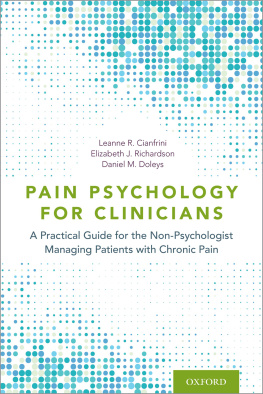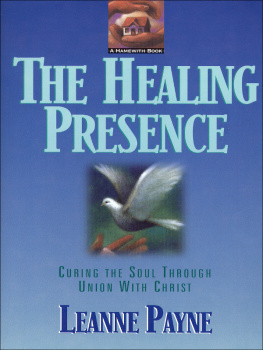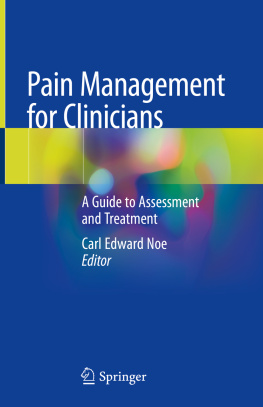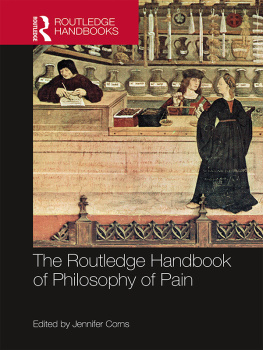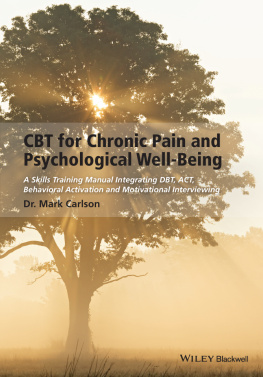Pain Psychology for Clinicians

Oxford University Press is a department of the University of Oxford. It furthers the Universitys objective of excellence in research, scholarship, and education by publishing worldwide. Oxford is a registered trade mark of Oxford University Press in the UK and certain other countries.
Published in the United States of America by Oxford University Press
198 Madison Avenue, New York, NY 10016, United States of America.
Oxford University Press 2021
All rights reserved. No part of this publication may be reproduced, stored in a retrieval system, or transmitted, in any form or by any means, without the prior permission in writing of Oxford University Press, or as expressly permitted by law, by license, or under terms agreed with the appropriate reproduction rights organization. Inquiries concerning reproduction outside the scope of the above should be sent to the Rights Department, Oxford University Press, at the address above.
You must not circulate this work in any other form and you must impose this same condition on any acquirer.
Library of Congress Cataloging-in-Publication Data
Names: Cianfrini, Leanne R., author. | Richardson, Elizabeth J. author. |
Doleys, Daniel M., author.
Title: Pain psychology for clinicians : a practical guide for the
non-psychologist managing patients with chronic pain /
Leanne R. Cianfrini, Elizabeth J. Richardson, Daniel M. Doleys.
Description: New York, NY : Oxford University Press, [2021] |
Includes bibliographical references and index.
Identifiers: LCCN 2020039400 (print) | LCCN 2020039401 (ebook) |
ISBN 9780197504727 (paperback) | ISBN 9780197504741 (epub) |
ISBN 9780197504758
Subjects: MESH: Pain Managementmethods | Chronic Painpsychology |
Primary Health Care | Physician-Patient Relations
Classification: LCC RB127 (print) | LCC RB127 (ebook) | NLM WL 704.6 |
DDC 616/.0472dc23
LC record available at https://lccn.loc.gov/2020039400
LC ebook record available at https://lccn.loc.gov/2020039401
DOI: 10.1093/med/9780197504727.001.0001
This material is not intended to be, and should not be considered, a substitute for medical or other professional advice. Treatment for the conditions described in this material is highly dependent on the individual circumstances. And, while this material is designed to offer accurate information with respect to the subject matter covered and to be current as of the time it was written, research and knowledge about medical and health issues are constantly evolving and dose schedules for medications are being revised continually, with new side effects recognized and accounted for regularly. Readers must therefore always check the product information and clinical procedures with the most up-to-date published product information and data sheets provided by the manufacturers and the most recent codes of conduct and safety regulation. The publisher and the author make no representations or warranties to readers, express or implied, as to the accuracy or completeness of this material. Without limiting the foregoing, the publisher and the author make no representations or warranties as to the accuracy or efficacy of the drug dosages mentioned in the material. The author and the publisher do not accept,and expressly disclaim, any responsibility for any liability, loss, or risk that may be claimed or incurred as a consequence of the use and/ or application of any of the contents of this material.
Contents
Daniel M. Doleys
Elizabeth J. Richardson
Leanne R. Cianfrini
Leanne R. Cianfrini
Leanne R. Cianfrini
Leanne R. Cianfrini
Elizabeth J. Richardson
Leanne R. Cianfrini
Daniel M. Doleys
Estimates suggest that 50 to 100 million persons in the United States suffer from some kind of chronic pain condition. There is no indication that the prevalence or incidence is decreasing with time. Indeed, the number of hospital admissions for children complaining of pain is increasing. Chronic pain has finally come to be recognized as a disease process, not unlike diabetes and hypertension.

